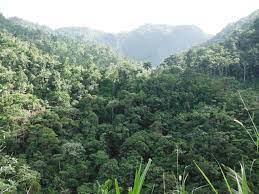 The German Oro Verde foundation recognized the results in 2023 of the international Green Basin project, focused, for five years, on natural conservation actions for the hydrographic system of the Jaguaní River, the main sub-basin of the Toa River, the largest in Cuba and one of the most important aquifer reserves in the country.
The German Oro Verde foundation recognized the results in 2023 of the international Green Basin project, focused, for five years, on natural conservation actions for the hydrographic system of the Jaguaní River, the main sub-basin of the Toa River, the largest in Cuba and one of the most important aquifer reserves in the country.
In that area at the Cuban easternmost end, there are some five thousand hectares of valuable remnants of Amazonian-type rainforests, with high endemism of flora and fauna, and 25 tributaries flow with abundant and permanent crystalline flow.
The environmental initiative, also implemented in aquaria of national interest in Mexico, Guatemala and the Dominican Republic, closed its interventions since last December in areas of the municipalities Baracoa and Yateras, in Guantanamo Province and the municipality Moa, in Holguín Province.
Three of the four Conservation Departments of the Alejandro de Humboldt National Park (PNAH) are located in these territories, the main nucleus of the Cuchillas del Toa Biosphere Reserve, a protected area with the highest levels of biodiversity and Antillean endemism.
Mauricio Santamaría, international coordinator of the aforementioned non-governmental organization based in the Bonn City, in Germany, highlighted the high professionalism demonstrated by the Guantanamo researchers in meeting the project’s goals.
Among the most relevant results, he noted the increase in vegetation cover, the creation of agricultural and forestry seed banks, and the installation of four automatic meteorological stations in Taco Bay, Baracoa; Cupeyal del Norte and Ojito de Agua, in Yateras, and La Melba, in Moa, Holguín.
With Wi-Fi technology and solar panels, these facilities cover 75 percent of the surface of the PNAH and are capable of recording the variables of temperature, relative humidity, evaporation, sunshine, and wind direction and intensity, with the support of computer systems to summarize indicators and give weather forecasts.
Santamaría commented that another valuable contribution was the training in biodiversity management for 98 inhabitants in the interior areas of Jaguaní, of which 32 sustain their livelihoods on soil and forest resources.
He also praised the strengthening of eight control actions cooperated with the regulatory bodies of the provinces Guantanamo and Holguín, for the identification and prevention of illegalities related to access to natural resources.
He also assured that the valuable Cuban experiences in Cuencas Verdes could be replicated in other countries in the region, while he praised the progress of the implementation of ecosystem-based adaptation measures (EbA) in Cuba, as a result of the presentation of 16 presentations at national and international events.
Doctor of Science Bárbaro Zabala Lahitte, coordinator in Cuba, explained that today the Jaguaní sub-basin has a management plan and innovative governance mechanisms so that EbA measures are incorporated into the territorial planning and management plans of the protected area.
These provisions aim to prepare people in the rational use of resources to face the effects of climate change and increase the resilience of forests and ecosystem services, especially water services.
Zabala Lahitte described as central the economic valuation of the forest resource in the sub-basin, estimated at more than nine billion pesos, especially for its capacity to capture large quantities of carbon dioxide (Co2) in the atmosphere, fix the gas in the roots from trees and soil, and then release abundant oxygen.
The Alejandro de Humboldt Provincial Center for Environmental and Technological Services, attached to the National Center for Protected Areas, was the entity in charge of executing the initiative, for which Oro Verde donated more than 450 thousand Euros and the Cuban Government provided some 284 thousand pesos.
Translated by Liubis Balart Martínez